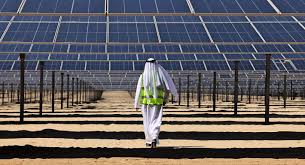The Future of Energy: Gulf States’ Transition to Renewables
For decades, the Gulf States—comprising Saudi Arabia, the UAE, Qatar, Kuwait, Bahrain, and Oman—have been synonymous with oil wealth. Their economic development, global influence, and modernization have been largely powered by hydrocarbons. However, with climate change concerns, global sustainability goals, and declining oil demand in the long term, the Gulf is now pivoting toward a renewable energy future.
This article explores how and why Gulf countries are transitioning to renewables, the progress made so far, and what lies ahead.
Why the Shift Toward Renewable Energy?
1. Global Climate Commitments
The Gulf States are signatories to international climate agreements like the Paris Accord. There is growing global pressure on oil-rich countries to reduce carbon emissions and invest in cleaner energy.
2. Economic Diversification
Post-oil strategies like Saudi Arabia’s Vision 2030 and UAE’s Energy Strategy 2050 aim to reduce economic reliance on oil by expanding renewable energy, technology, tourism, and manufacturing sectors.
3. Declining Oil Demand
As electric vehicles and green energy rise globally, long-term oil demand is expected to shrink. Future-ready economies require alternative revenue streams and energy sources.
Major Renewable Projects in the Gulf
The Gulf has invested billions in renewable energy infrastructure. Here are some landmark projects:
🇸🇦 Saudi Arabia: NEOM & Sakaka Solar Plant
- NEOM: A $500 billion futuristic city powered entirely by renewable energy, including wind, solar, and green hydrogen.
- Sakaka PV Plant: One of the largest solar power stations in the kingdom with a capacity of 300 MW.
🇦🇪 United Arab Emirates: Masdar City & Mohammed bin Rashid Al Maktoum Solar Park
- Masdar City (Abu Dhabi): A hub for sustainability and clean tech innovation.
- MBR Solar Park (Dubai): One of the largest single-site solar parks in the world, aiming to produce 5,000 MW by 2030.
🇶🇦 Qatar: Al Kharsaah Solar Plant
- Aims to produce 800 MW of power and meet 10% of the country’s peak electricity demand.
🇴🇲 Oman: Miraah Solar Thermal Project
- Focuses on using solar steam to support oil extraction, showing hybrid energy potential.
The Role of Solar and Wind Energy
The Gulf is geographically ideal for renewable energy due to:
- High solar irradiance: Over 300 sunny days annually.
- Vast open desert land: Ideal for large solar farms.
- Steady coastal winds: Enabling wind energy in select areas.
Solar remains the most promising source, but green hydrogen—produced using renewable energy—is emerging as a major future export opportunity.
Green Hydrogen: The Gulf’s Next Big Export?
Countries like Saudi Arabia and Oman are investing heavily in green hydrogen, which could become the “new oil” in a decarbonized world.
- Saudi’s NEOM Green Hydrogen Project is set to produce 650 tons of hydrogen daily by 2026.
- Oman’s Hydrogen Oman (Hydrom) platform aims to position the country as a global hydrogen hub.
This focus aligns with Europe and Asia’s growing demand for clean fuels.
Obstacles in the Transition
While the shift is promising, challenges remain:
1. Dependence on Fossil Fuel Revenue
Oil and gas still make up a large share of GDP and government budgets. Transitioning away without economic shocks is complex.
2. Infrastructure Readiness
Power grids must be modernized to integrate intermittent renewable sources like solar and wind.
3. Water-Energy Nexus
Desalination—essential in Gulf nations—requires a lot of energy. Transitioning this process to renewables is still in early stages.
4. Public Awareness
Green lifestyle adoption among residents and businesses is still evolving. Government-driven initiatives remain the main force behind the energy shift.
What the Future Holds
Despite the hurdles, the Gulf’s transition to renewables is accelerating.
Expected Trends by 2030:
- Renewables could supply 25–50% of power in countries like UAE and Saudi Arabia.
- Increased energy efficiency measures in homes, businesses, and transport.
- Electric vehicle adoption supported by solar-powered charging networks.
- Regional clean energy collaboration, including GCC power-sharing grids.
The Gulf may also become a global exporter of clean energy, not just oil and gas.
Conclusion: From Oil Giants to Green Innovators
The Gulf States are proving that even the world’s top oil exporters can lead in the renewable revolution. Through bold policies, mega-projects, and international partnerships, these nations are laying the foundation for a cleaner, more sustainable future.
Their journey is not just about energy—it’s about long-term survival, innovation, and global relevance in a rapidly changing world.





